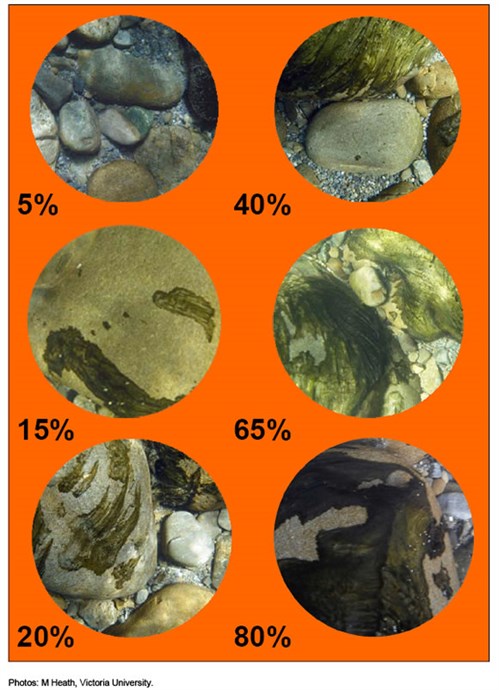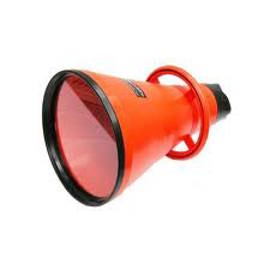What are toxic algae?
Toxic algae is a common name for toxic cyanobacteria. Cyanobacteria are microscopic organisms that play a very important role in many land and aquatic ecosystems. Cyanobacteria are naturally occurring and live in a range of waterways, from near-pristine to those more impacted by land-use. Some cyanobacteria can produce toxins that are harmful to animals and humans.
In aquatic environments, cyanobacteria can multiply and form blooms suspended in the water (known as planktonic) or dense mats attached to rocks on riverbeds (known as benthic). Planktonic blooms are generally found in slow moving water-ways such as lakes, while benthic blooms usually occur in rivers.
Why can toxic algae be a problem?
Toxic algae can become a problem when they increase to high concentrations, forming ‘blooms’. Most of the year toxic algae are present at low levels that are not much of a danger. Blooms are more common during the summer months, when low rainfall, warm temperatures, the right level of nutrients and more sunlight create an environment where it can thrive.
Other than the general effects of algal blooms on waterways (e.g. reduction in dissolved oxygen and light in the water column), an increasing number of cyanobacterial species are known to produce toxins. These natural toxins, known as cyanotoxins, can be a threat to humans and animals when eaten, even licked, or when water containing the toxins is swallowed. The conditions for when they can become toxic is not well understood, and the levels of toxicity can only be determined by laboratory testing. This is why it is safest to treat the blooms as if they are toxic at all times.
What does toxic algae look like in rivers?
In rivers (and occasionally lakes), toxic algae generally form brown or black mats that grow on rocks in the riverbed (also called benthic). Mats that come loose from the riverbed can wash up on the banks or form floating ‘rafts’ in shallow areas. The mats can also become exposed during low flows. When exposed, the mats may dry out and turn a light brown or white colour and may also produce a strong musty odour. Toxic algae differs from harmless bright green algae, which often form long filaments.


Mat forming benthic toxic algae attached to rocks


Mat forming benthic toxic algae washed up on the water's edge
What does toxic algae look like in lakes?
In lakes and slow-flowing waters, toxic algae grow in a free-floating (also called planktonic) form which can cause the water to become murky or cloudy. Planktonic cyanobacterial blooms are generally green in colour and can give lakes a ‘pea soup’ appearance. They can also form visible green to red films or scums on the water’s surface, especially at the water’s edge.

A planktonic cyanobacterial bloom in a lake
What is the impact on people?
Exposure to high levels of cyanobacteria toxins can cause serious illness or, in extreme cases, death in humans. The effects vary and can include symptoms such as rapid onset of nausea and diarrhoea, as well as more serious effects such as liver damage. These toxins have no known antidotes.
Exposure can occur through skin contact with affected water or ingestion, such as during activities like swimming or water-skiing. In some cases, people may experience an allergic reaction just from touching the toxic algae.
Children are particularly vulnerable because of their smaller body weight, which increases their relative dose of toxin. Toddlers are at even greater risk, as they are prone to putting objects into their mouths. Consuming even a small amount, equivalent to the size of a 50-cent coin, can cause serious harm.
What should I do if I’ve been exposed and I’m feeling unwell?
If you suspect you or someone else is experiencing symptoms from contact with toxic algae, seek immediate medical attention. Inform the doctor about the potential exposure to toxic algae and ask them to notify Regional Public Health.
What is the impact on pets and animals?
Dogs are at the greatest risk as they enjoy playing and scavenging in the water. Dog deaths linked to toxic algae in rivers have become increasingly common in New Zealand. Most cases involve dogs ingesting the mat-forming cyanobacteria (sometimes known as Phormidium, now renamed Microcoleus). These mats produce a deep, earthly smell that attracts dogs. The risk is highest when the mats detach from the riverbed and collect along the river's edge, making them easily accessible.
If you suspect that your dog has eaten toxic algae, treat it like an emergency and contact your vet immediately. In extreme cases, death can occur within 30 minutes of the first signs of illness. Symptoms of toxic toxic algae poisoning in dogs include lethargy, muscle tremors, rapid breathing, twitching, paralysis and convulsions.
Livestock can also be affected if they wander into waterways containing toxic algae and drink from them. To protect stock, arrange an alternative water source and keep them out of contaminated waterways.
How to keep yourself (and your pets) safe
The best way to stay safe is to be informed. Check the latest toxic algae monitoring results, look for warnings or alerts, and get to know what toxic algae looks like before visiting a river or lake. Toxic algae can quickly bloom under certain conditions, especially during hot periods, so learn to identify it.
If toxic algae are present, or you think you have spotted it, stay out of the water and avoid drinking or touching it. If you have swum in contaminated water, rinse off with fresh water as soon as possible - wearing a wetsuit will not protect you.
Keep your dog on a lead and out of the water. Most importantly, prevent your dog from touching, licking, or eating algae mats in the water or along the water’s edge. Do not let your dog drink water from the affected areas. If your dog has been in the water, stop them from licking their fur and wash them with fresh water immediately.
FAQs
Is it safe to drink water containing toxic algae?
No. Toxins are not removed by boiling, normal filter systems, steri-pen or UV light, or by adding household disinfectants. Arrange for alternative drinking water.
Is it safe to boat or canoe in water with toxic algae?
The safety of boating or canoeing depends on the amount of direct contact with the water. If you swallow the water or your skin is in contact with it while boating or canoeing, you are at risk of a reaction from any toxic algae present. The higher the concentration of toxic algae and the longer you are in contact with the water, the greater the risk. Wash boats, canoes, and life-jackets down with clean water after use.
My river has long, stringy green algae present. Is this dangerous?
No, this algae is typically a non-toxic green algae that appears in rivers when conditions are warm and sunlight hours longer, similar to how grass grows faster in the summer.
How is the risk from toxic algae assessed at swimming spots?
The risk from toxic algae in rivers and lakes is assessed by measuring either the percentage cover of the mat-forming cyanobacteria on rocks, or the number of cells of cyanobacteria suspended in the water. These measurements are compared to national guidelines for recreational areas in New Zealand to determine the risk to human health. More information is available in this factsheet.
Blooms are much more common in summer than in winter, so council recreational monitoring usually occurs during the warmer months when people are more likely to be recreating in waterways.
How is toxic algae measured?
Benthic toxic algae, which form mats on the riverbed, are assessed visually. The percentage cover is determined by using an underwater viewer called a bathyscope. The bathyscope allows the person assessing the riverbed to look through a lens to observe the coverage of toxic algae across the substrate. A transect, or predetermined path, is run across the river, and the percentage of riverbed covered by toxic algae is recorded at several points along the transect (see pictures below for examples of coverage). This process is repeated several times within a river area to ensure an accurate representation of coverage. An average percentage cover of toxic algae then calculated from these observations.
In addition, the river edge is scanned for detached or exposed mats that may have collected at the margins. Recreational users and animals have an increased risk of coming in contact with detached mats.


Examples of percentage cover of benthic cyanobacteria and what an underwater viewer (bathyscope) looks like.
For planktonic (suspended in the water) cyanobacteria, the process is different. Water samples are collected from the surface, and the number of cyanobacterial cells is counted, or the biovolume of the individual cells (the amount of space within a cell) is measured. Because different planktonic cyanobacteria may contain different amounts of toxins based on their cell size, biovolume provides a better estimate of potential risk than simple cell counts.
The amounts of mat forming (benthic) and planktonic (suspended) cyanobacteria are assessed using the New Zealand Guidelines for Cyanobacteria in Recreational Fresh Waters: Interim Guidelines.
